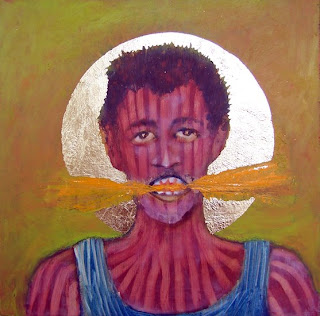As I’ve walked the Art Road (so to speak) I’ve discovered the occasional person whom I think of as a Fellow Traveler. This was a term used by Joseph McCarthy and his ilk to denote people who were Communist sympathizers, but not actual “card-carrying” Communists. Only instead of Communists, I’m meaning Artists. Whatever that is. Hmmm, and what would the card look like, anyway? And who keeps the minutes and makes the agenda?
I’m not sure what makes you a member of the Artist Party. I’ve often resisted calling myself an
artist. It seems a lot like calling yourself a
guru. If you appropriate the title (or confer it upon yourself), are you really entitled to it?
Sower, R.L. Croft
Sower is a subtle homage to van Gogh’s paintings of the same title in the form of an 11-foot-long maple seed (winged seed or “helicopter”) built in the manner of an airfoil. It features handles, an access panel and a view port. Sower rests on its own dolly, or on the floor propped by a short pole. It also carries long poles and guy wires for temporary, fair weather outdoor display in an oblique upright stance that abstractly mimics the painting’s striding figure.

Anyway, when I say Fellow Traveler, I mean someone who is “plowing the same field,” who seems drawn to similar materials, motifs, shapes, or icons. It’s not that he or she is a better artist (whatever that means) than other artists you know and love – just that they’re like
you, like a clone of some kind, like someone who’s making art that could be your own.
Perpetual notion machine, R.L. Croft
Perpetual notion machine (Sisyphus machine) is an absurdly low-tech comment on the fascination and trust we place in technology. Idealism found in promises of a better future are frustrated by the reality of mankind’s tendency to settle for significantly less. Included in its construction are a whisper/ball tube, a malfunctioning solar powered thermometer and dead switches. Its main feature is a hidden ball track. The viewer can insert a ball bearing into an opening and listen to its clanking progress until it emerges at the bottom, beckoning for perpetual performance of a meaningless task.

Such a person, named Robin Croft, popped into my life recently. The wheeled pieces on his
website (under
Floorwork) are wonderful, and the piece called
Platform, Madrid on the
Wallwork page dramatically conveys the bomb-blast in the metro, as well as the injured and killed, represented (amazingly and accurately) by bottles of nail polish!
Platform, Madrid, R.L. Croft

Robin says, “My intention is to create the effect of two conflicting forces, that which touches on the depths of despair, unsteadily balanced against anxious humor and simple joy in work. Idealism found in promises of a better future are frustrated by the reality of mankind’s tendency to settle for significantly less. These sculptures are abandoned visual props left at the end of an absurd solitary performance, susceptible to decay and multiple interpretations. Nothing can be taken for granted. Constant change proves to be the only reliable point of reference. Equilibrium being evanescent, one tries to fuse an array of thought fragments into a drawing of graphite or metal. By doing so, the artist builds a fragile mental world of metaphor that lends meaning to his largely unnoticed visit in society.”
Platform, Madrid (detail), R.L. Croft

Why do artists clump together? Sometimes it’s for more or less venal (or at least self-promotional) reasons: Making contacts with others puts us in the way of opportunities, and gets us out in the world through “friending” people (that irritating expression). Sometimes it’s just a need for the companionship of others who are in the life (of art). But I think it can also be a genuine recognition of an artistic doppelganger, a person whose work (and, possibly, aesthetic motivations) are continuous with your own.
 Fellow Travelers of another kind, these Priests are secular clerics, our comrades.
Fellow Travelers of another kind, these Priests are secular clerics, our comrades.

















